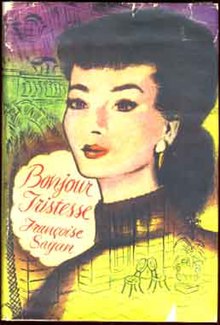Bonjour Tristesse
 First English edition | |
| Author | Françoise Sagan |
|---|---|
| Language | French |
| Publisher | Éditions Julliard (France) John Murray (UK) |
Publication date | 1954 |
| Publication place | France |
Published in English | 1955 |
Bonjour Tristesse (Template:Lang-en) is a novel by Françoise Sagan. Published in 1954, when the author was only 18, it was an overnight sensation. The title is derived from a poem by Paul Éluard, "À peine défigurée", which begins with the lines "Adieu tristesse/Bonjour tristesse..." An English-language film adaptation was released in 1958, directed by Otto Preminger.[1]
Plot summary
17-year-old Cécile spends her summer in a villa on the French Riviera with her father Raymond and his current mistress, the young, superficial, fashionable Elsa, who gets on well with Cécile. Raymond is an attractive, worldly, amoral man who excuses his serial philandering with an Oscar Wilde quote about sin: "Sin is the only note of vivid colour that persists in the modern world." Cécile says, "I believed that I could base my life on it",[2] and accepts their lifestyle as typical. One of its advantages for her is that her father, who has no intellectual interests, does not care if she studies or not. Another is that he leaves her a free hand at attracting men. Though she initially tries men of her father's age, in the next villa to theirs is a young man in his 20s, Cyril, with whom she starts a romance.
This peaceful holiday foursome is shattered by the arrival of Anne, whom Raymond had vaguely invited. A cultured, principled, intelligent, hard-working woman of Raymond's age who was a friend of his late wife, she regards herself as a sort of godmother to Cécile. A contest develops among the three women, which Anne wins by sleeping with Raymond and next morning announcing their engagement. Elsa moves out, then Anne starts on Cécile. She tells her to stop seeing Cyril and get back to her schoolbooks. Horrified at this threat to her lazy life as her father's darling, Cécile devises a plan to prevent the marriage.
With the idea of making Raymond jealous, she arranges for Elsa and Cyril to pretend to be a couple and appear together at specific moments. When Raymond can't take their togetherness any longer, he goes off to find Elsa. But Cécile has misjudged Anne's sensitivity, with tragic results. Seeing the two close together in the woods, she storms off in her car and plunges from a cliff in a suspected suicide. It later emerges that Raymond and Elsa were only kissing.
Cécile and her father return to the empty, desultory life they were living before Anne interrupted their summer.
Characters
- Cécile, a wealthy and careless seventeen-year-old girl
- Raymond, her middle-aged father, a notorious partier and ladies' man
- Elsa, Raymond's latest mistress at the beginning of the novel
- Anne, an old friend of Cécile's family, who raised Cécile after her mother died
- Cyril, a young man who lives near the house Raymond rents for the summer
Reception
An early brief review of Irene Ash's English translation (John Murray, 1955), in The Times of 19 May 1955, describes it as "An unusual little fiction ... written by a 19-year-old girl from the Dordogne ... a nice piece of precocity".[3] The reviewer in The Spectator of the same date said "Bonjour, Tristesse, which has achieved remarkable celebrity by virtue of its subject-matter and its authoress's age, is a vulgar, sad little book".[4]
See also
References
- ^ Camper, Fred (1999). Bodies in Motion
- ^ Gleeson, Sinéad (2004). Bibliofemme review
- ^ "The Old Adversary (book reviews)". The Times. 19 May 1955. p. 13. Retrieved 22 February 2016.
{{cite news}}: Unknown parameter|subscription=ignored (|url-access=suggested) (help) - ^ Metcalf, John (19 May 1955). "New novels". The Spectator. p. 31. Retrieved 23 February 2016.
